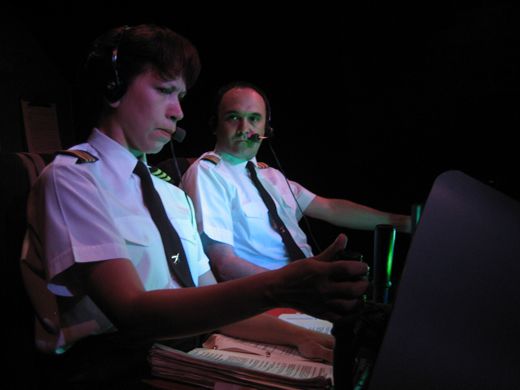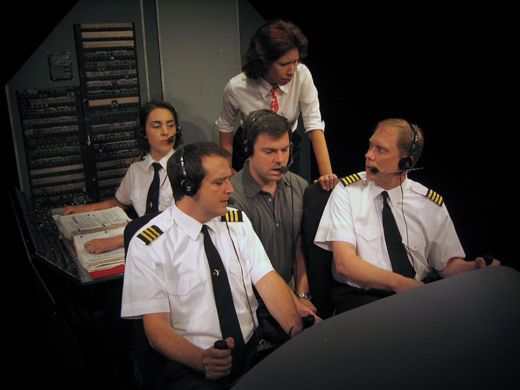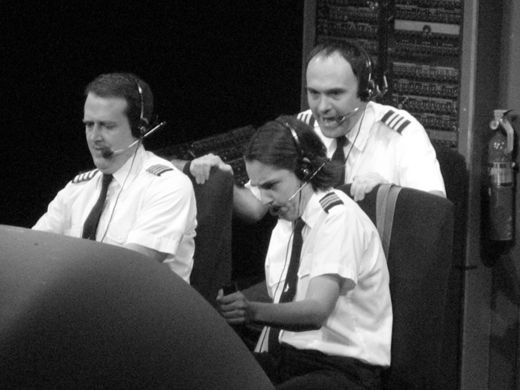Drama in the Cockpit
The last words of doomed airline crews make for riveting theater.
/https://tf-cmsv2-smithsonianmag-media.s3.amazonaws.com/filer/CVR-388-sept06.jpg)
The horrific sound of fracturing metal releases a flood of adrenaline as we watch the airline crew struggle to make sense of the chaos that surrounds them.
The play "Charlie Victor Romeo," which stands for cockpit voice recorder, is presented on a stark set: the cockpit of an airliner with crews at the controls, actors whose lines are taken verbatim from the CVRs of six real-life crashes. The tense exchanges among pilots, co-pilots, flight attendants, and air traffic controllers are stunning for their calm professionalism in the face of impending disaster.
The play was conceived by Patrick Daniels, Robert Berger, and Irving Gregory of the Manhattan-based experimental theater group Collective: Unconscious. None of the three has an aviation background. Drawing from "The Black Box: All-New Cockpit Voice Recorder Accounts of In-Flight Accidents," edited by Malcolm McPherson, the production debuted in 1999, picked up numerous drama awards, and has since played to enthusiastic reviews across the country as well as in Australia and Japan (check the U.S. Air Force videotaped a performance to better educate aircrews on good—and bad—decision making. Healthcare professionals have used "Charlie Victor Romeo" to learn from the parallels between aviation and emergency medicine.
In one re-creation, mercifully brief, a Boeing AWACS E-3 takes off from Elmendorf Air Force Base in Alaska in 1995 as a departing C-130 disturbs a flock of geese. Though a controller in the tower takes note of the birds, he neglects to notify the AWACS crew, and its engines ingest numerous geese, causing a complete loss of control. ("Goin’ down. Oh my God. Okay, give it all you got, give it all you got. Two Seven heavy, emergency. Crash landing. We’re goin’ in. We’re goin’ down.") The airplane explodes on impact—no survivors.
In another vignette, an Aeroperu Boeing 757 crew takes off at night from Lima unaware that their static-air ports have been taped over by a cleaning staff—a death sentence, as it renders the airspeed and altitude readings wildly inaccurate. ("We are impacting water! Pull it up. I have it, I have it! We are going to invert!") The aircraft hits the ocean at 300 mph, skips like a stone, and sinks—no survivors.
The closing account is the now legendary 1989 Sioux City crash of a United DC-10 that lost all hydraulics when the tail engine exploded. Al Haynes, with the help of an instructor pilot on board and the rest of the crew, controls the crippled airliner using the thrust of the remaining two engines. ("Back, Al! Left throttle! Left, left, left, left, left, left, left, left! Everybody stay in brace! GOD!") Though the right wing and tail break off, the right gear collapses on touchdown, and the aircraft bursts into flames, 184 out of the 296 on board survive.
The actors hold a question-and-answer session after each show for their benefit as well as for the audience, since it gives them a chance to cool down emotionally. At the performance I attended in Washington, D.C., last June, a post-show head count indicated about 40 percent aviation people, 60 percent drama fans. The propeller-heads asked about hardware; the drama people asked how the actors rated their roles compared to performing, say, Shakespeare.
As grim as the "Charlie Victor Romeo" experience is—of the six accidents, only half had survivors—critics and audiences alike emerge profoundly affected by the courage of airline crews in the middle of their worst nightmare.


